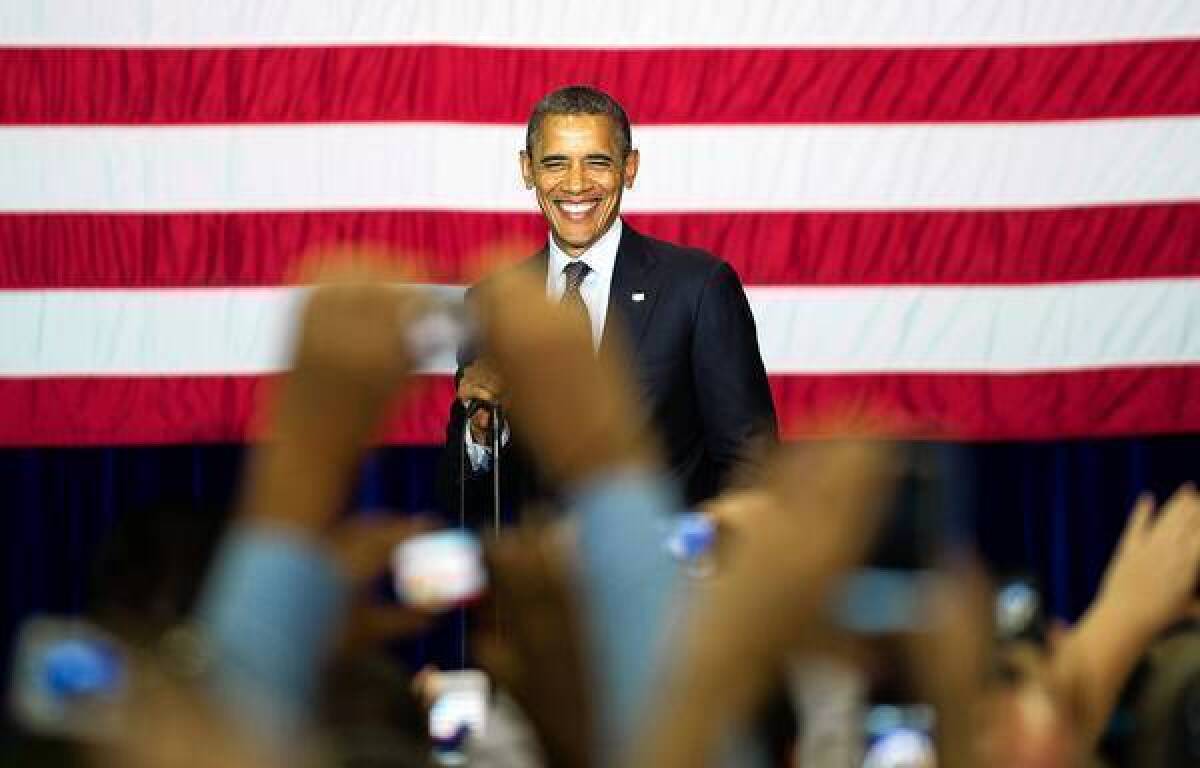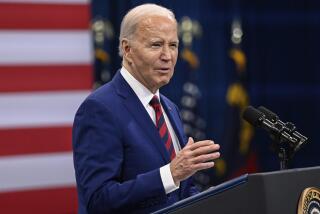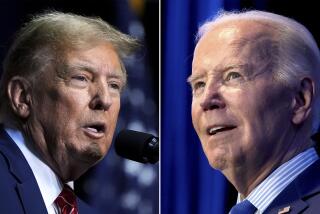Obama has slight lead over Romney in new nationwide poll

WASHINGTON — With his running mate in place and his nominating convention looming, Republican Mitt Romney narrowly trails President Obama, according to a new nationwide poll of likely voters.
Obama leads 48% to 45% among all registered voters in the survey and by 48% to 46% among those considered likely to vote, according to the USC Annenberg/Los Angeles Times poll on Politics and the Press.
While those results are within the poll’s margin of error, they speak to the remarkable stability of the presidential race, in which Obama has held a small lead in most polls since April. The vast majority of voters have taken sides in the race — only 3% of likely voters in the poll declared themselves undecided with another 3% saying that they “leaned” toward one candidate or the other — and partisan divisions have been stark.
Full Text of Poll Questions and Methodology
Voters divide evenly on whether they approve of Obama’s job performance. But the president’s standing has been buoyed by an overall favorable impression that voters have of him as well as doubts they have regarding Romney.
Among likely voters, 53% view Obama favorably and 45% unfavorably. By contrast, Romney struggles with a narrow deficit on that question — likely voters view him unfavorably by 46% to 48%, close to an even split.
As with the overall head-to-head figures, the gap in how voters view the candidates, measured repeatedly by a wide variety of surveys, has not moved significantly for months. Romney’s campaign has invested heavily in trying to erode Obama’s favorable image, but so far, that effort has not succeeded. Nor has Obama’s effort to push up the percentage of voters who view Romney negatively.
“The description for this race is ‘static,’ ” said pollster Drew Lieberman, representing the Democratic half of the bipartisan team of polling firms that conducted the survey.
Obama’s job approval figures are almost identical to those that former President George W. Bush had at this point in his reelection campaign in 2004, Lieberman noted, but the gap on favorability gives Obama an advantage that was not present in Bush’s matchup against that year’s Democratic nominee, Sen. John F. Kerry (D-Mass.).
His Republican counterpart, David Kanevsky, echoes much of that. For both sides “it’s a question of defining Romney,” he said. Voters have deeply held views of Obama, but Romney’s image remains lightly sketched for many. That gives Romney’s support room to grow if all goes well, but also presents the risk he could slide backward.
The Democratic ticket also has the advantage on two issues tested by the poll that motivate important groups of voters — taxes and immigration.
Romney says that tax cuts passed under George W. Bush, which are set to expire at the end of the year, should be extended for all incomes. Obama says that taxes should be allowed to go up for incomes over $250,000.
By 43% to 37%, likely voters sided with Obama. An additional 13% of likely voters would go further and allow all the Bush-era tax cuts to expire.
Conservatives sided heavily with Romney on the issue, but liberals and moderates both backed Obama’s stand. Voters who identified themselves as independents split closely — 42% supporting Romney’s position, 38% Obama’s and 12% saying all the tax cuts should expire.
On immigration, the poll asked voters about Obama’s proposal to allow citizenship for so-called Dream Act immigrants — illegal residents who were brought to the U.S. as children, have maintained a clean record and have completed either college or military service. Romney has opposed the idea, taking a strong position against it during the Republican primary contest.
By a 2-1 margin, likely voters sided with Obama on the issue. The margin was particularly large, 70% to 22%, among minority voters, including both blacks and Latinos.
Support from minority voters is key to Obama’s reelection chances. In the poll, Romney leads among white voters, 55% to 39%, but Obama leads 76% to 17% among minority voters, including a 68% to 27% lead among Latinos and a nearly unanimous 92% to 2% margin among blacks.
Obama put together a winning coalition in 2008 that combined minority voters with young voters of all ethnicities and whites who had a graduate or professional education. Since then, he’s lost ground among voters younger than 30 — although he still leads among them. He continues to command the same level of loyalty among minority voters that he achieved four years ago, but a major question remains whether they will turn out at the same level they did in 2008 or stay home, as many minority voters did during the midterm election in 2010.
Romney is strongest among white voters, particularly self-described conservatives, those older than 65 and those who frequently attend religious services. He also leads among voters who have some college education, but not a degree. The two candidates are evenly divided among people whose highest degree is a bachelor’s.
The divisions along lines of age, gender and education that the poll highlights help explain why the campaigns have emphasized certain issues in the last two weeks.
Romney, for example, has the narrow backing of men, 48% to 44%, while Obama has a somewhat larger lead among women, 51% to 43%. That gender gap exists largely because Obama has overwhelming support, 71% to 19%, among single women.
Democratic strategists have said for many years that abortion, contraception and related issues have particular importance for how single women vote. The Obama campaign was deploying those issues against Romney even before the Republican Senate candidate in Missouri, Rep. Todd Akin, focused an intense spotlight on the subject this week with his comments about abortion and rape.
Obama has an edge among all voters younger than 50, offsetting Romney’s backing among those 65 and older. The two are almost evenly divided among voters ages 50 to 64. That group, which takes in the younger part of the baby boom generation, is a key battleground in the fight over the Medicare plan written by Romney’s running mate, Rep.Paul D. Ryan (R-Wis.). His plan would convert Medicare into a voucher system beginning with people currently age 55.
Both candidates receive overwhelming support from their parties, with roughly 9 in 10 Democrats behind Obama and a similar percentage of Republicans backing Romney. Liberals back Obama and conservatives back Romney. Although conservatives outnumber liberals in the electorate, Obama maintains a 55% to 34% lead among ideological moderates.
The findings are part of a larger survey on where voters obtain information about the campaign and what media sources they trust. Results on that portion of the poll will be released Friday. The survey was conducted Aug. 13 to 19 for The Times and USC by the Democratic firm Greenberg Quinlan Rosner Research and the Republican firm American Viewpoint. It surveyed 1,009 registered voters of whom 954 were considered likely voters. The results have a margin of error of 3.1 percentage points for registered voters and 3.2 points for likely voters.
More to Read
Get the L.A. Times Politics newsletter
Deeply reported insights into legislation, politics and policy from Sacramento, Washington and beyond. In your inbox three times per week.
You may occasionally receive promotional content from the Los Angeles Times.







